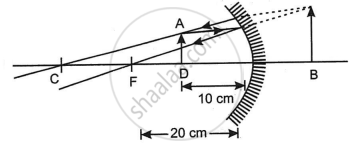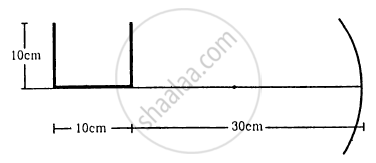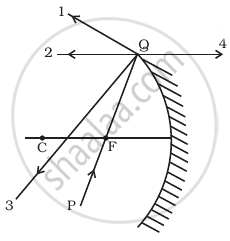Advertisements
Advertisements
Question
If an object is placed at a distance of 10 cm in front of a concave mirror of a focal length of 20 cm, the image formed will be ______.
Options
Real and 20 cm in front of the mirror
Real and 6.67 cm in front of the mirror.
Virtual and 20 cm behind the mirror.
Virtual and 6.67 cm behind the mirror.
Solution
If an object is placed at a distance of 10 cm in front of a concave mirror of a focal length of 20 cm, the image formed will be virtual and 20 cm behind the mirror.
Explanation:

Given, f = - 20 cm; u = - 10 cm
Using the formula
`1/"f" = 1/"v" + 1/"u"`
`=> 1/(- 20) = 1/v - 1/10`
`=> 1/10 - 1/20 = 1/v`
`=> 1/v = 1/20`
⇒ v = 20 cm
APPEARS IN
RELATED QUESTIONS
In image formation from spherical mirrors, only paraxial rays are considered because they
A U-shaped wire is placed before a concave mirror having radius of curvature 20 cm as shown in figure. Find the total length of the image.

A narrow pencil of parallel light is incident normally on a solid transparent sphere of radius r. What should be the refractive index is the pencil is to be focussed (a) at the surface of the sphere, (b) at the centre of the sphere.
A converging lens of focal length 12 cm and a diverging mirror of focal length 7.5 cm are placed 5.0 cm apart with their principal axes coinciding. Where should an object be placed so that its image falls on itself?
A converging lens of focal length 40 cm is kept in contact with a diverging lens of focal length 30 cm. Find the focal length of the combination .
State how the focal length of a glass lens (Refractive Index 1.5) changes when it is completely immersed in:
(i) Water (Refractive Index 1.33)
(ii) A liquid (Refractive Index 1.65)
According to Cartesian sign convention, all distances are measured from the _______.
The direction of ray of light incident on a concave mirror is shown by PQ while directions in which the ray would travel after reflection is shown by four rays marked 1, 2, 3 and 4 (figure). Which of the four rays correctly shows the direction of reflected ray?

An astronomical refractive telescope has an objective of focal length 20 m and an eyepiece of focal length 2 cm.
- The length of the telescope tube is 20.02 m.
- The magnification is 1000.
- The image formed is inverted.
- An objective of a larger aperture will increase the brightness and reduce chromatic aberration of the image.
A thin convex lens of focal length 25 cm is cut into two pieces 0.5 cm above the principal axis. The top part is placed at (0, 0) and an object placed at (– 50 cm, 0). Find the coordinates of the image.
